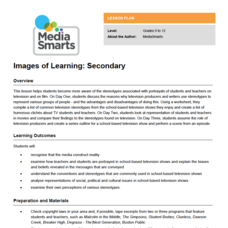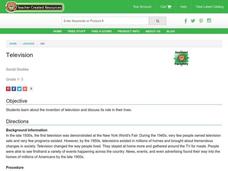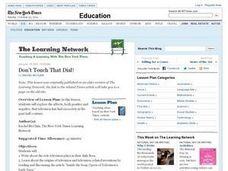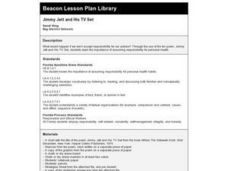Media Smarts
Images of Learning: Secondary
Make your scholars more aware of stereotypical portrayals in film and television. Discuss the definition of "stereotypes" and how they are used to present a story. High schoolers look at specific television shows and complete a chart...
Curated OER
Art Reflecting Life
Have your young television viewers discuss popular shows among their peers. After choosing one show to analyze, middle and high schoolers read about the 2007-2008 network television lineup with the New York Times article "Gauging Viewer...
Media Smarts
How to Analyze the News
Teach kids how to watch television, specifically the news, with this creative idea for learners of all ages from the Media Awareness Network. The elementary school plan focuses on presenting news as a story and uses Jon Scieszka's story...
Media Smarts
Cinema Cops
A study of how public perception is both reflected and influenced by film and television, this instructional activity helps students develop an awareness of audience as well as a critical view of media. Depictions of police in television...
Media Smarts
Scripting a Crime Drama
Develop novice script-writers. Small groups sift through a sample script, noting any script-writing conventions to share with the whole class. Using these conventions and plot structures, these groups compose a script for a 10-minute...
Curated OER
The 1950s:
Teens will get a kick out of this presentation, which provides a glimpse of the consumerism and rising pop culture of 1950's America. They will especially appreciate the discussion of "Teen culture" including the music of Elvis, the...
Curated OER
News
How does broadcast news differ from accounts reported in newspapers? On the radio? Through the Internet? Middle schoolers discuss the news and speak about the differences between news in print and broadcast news. Given a list of six...
Curated OER
The Mass Media and Politics
What effect do the prevalence of televisions in homes have on the American political stage? Challenge your students to consider this idea with these ten questions, both true/false and multiple choice. You could use this activity as a...
Curated OER
TV Tells it All
Students discuss the concept of gender bias and stereotyping. In this social science lesson, students determine what the influence of television on gender roles represents and compares the chage in gender roles of today to those of their...
Curated OER
Is the Brady Bunch Biased
Learners examine gender bias on television and in the movies. In this social science lesson, students watch various shows and when an instance of stereotypical behavior, or gender bias situation occurs, learners think about the problem....
Curated OER
The Electric Hearth
Students examine popular media. In this media awareness lesson plan, students keep logs of their interactions with media and then write an essay regarding the data.
Curated OER
Television
Students investigate the invention of television and examine its role in their lives. They read and discuss an informational handout, list the pros and cons of television on a worksheet, and create a class pie graph illustrating the...
Curated OER
"The New Television Set" a Gateway to the Post World War II Era
Eleventh graders demonstrate their knowledge of the effects of television on the political, economic, religious, social, intellectual and artistic life of the US nation from the 1950's. Research how television shaped public opinion with...
Curated OER
Don't Touch That Dial!
Students explore the affects, both positive and negative, that television has had on society in the past half-century. They read the article "Inside the Soap Opera of Television's Early Days."
Curated OER
Irregularly Scheduled Programming
Learners examine their favorite holidays and how they are celebrated. After reading an article, they discuss the length of television programming for the Super Bowl. In groups, they create their own television programming relating to...
Curated OER
Rewrite, Revise, Recycle
Students examine different pieces of literature that have a similiar theme. They read an article about reusing ideas for television shows. They work together to create their own program proposals. They also create backstories for one of...
Curated OER
Television Goes Digital
Middle schoolers explore the difference between analog and digital televisions. They examine how the technology works and the impact of television through history. They also compare older television sets to ones found today.
Curated OER
Tee-Hee T.V.
Students examine the concept of satire by reading lyrics to a song and reading "Soap and the Campus: A Web-Site Spoof Succeeds." They create treatments for parodies based on current television shows.
Curated OER
Jimmy Jett and His TV Set
Fourth graders engage withh the fun poem, Jimmy Jett and His TV, to explain the iimportance of assuming responsibility for personal health.
Curated OER
Understanding: Television
Learners discuss their experiences with television. They break into small groups and go through the steps of producing a television show themselves. Their presentations are made to the entire class.
Curated OER
Literary Criticism
Students evaluate and debate whether movies, television shows, and other mass media cause violent behavior in students and whether books are the same as or different from these other media in their potential for causing violent behavior...
Curated OER
Newspapers or Television: What's Better?
Students compare newspapers to television news and decide which they prefer. In this newspaper and television lesson, students read an article and watch a video of the same event. Students discuss the differences, forming an opinion on...
Curated OER
Levittown, Automobiles, and Cultures of the 1950's
Students investigate the impact of the automobile on Americans. In this 1950's America lesson, students listen to audio clips, read about Levittown, and explore the Interstate Highway Act from the decade. Students then discuss their...
Curated OER
1950’s American Culture: Television, Fashion, and Music
Sixth graders investigate the impact of popular culture on Americans. In this 1950's America lesson, 6th graders view television clips, listen to audio clips, and look over fashion photographs from the decade. Students then discuss...

























